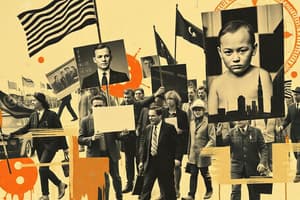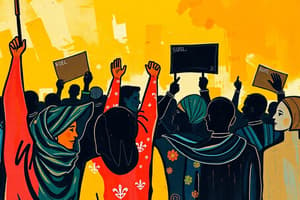Podcast
Questions and Answers
Match the type of social movement to its corresponding aim and target.
Match the type of social movement to its corresponding aim and target.
Alternative social movement = Aim for limited societal change, target narrow group of people. Redemptive social movement = Aim for more radical change, target specific groups. Reformative social movement = Aim for limited social change, across entire society. Revolutionary social movement = Aim for radical reorganization of society.
What does the 'value added theory' refer to?
What does the 'value added theory' refer to?
Planned collective action, social movements increase in value in a series of progressive stages to achieve a successful outcome.
What is the central idea behind the 'Emergent Norm theory'?
What is the central idea behind the 'Emergent Norm theory'?
New behavioral norms emerge in crowds in response to a precipitating crisis, leading to collective action.
The 'Contagion theory' suggests that collective action arises from people's tendency to conform to others in close contact.
The 'Contagion theory' suggests that collective action arises from people's tendency to conform to others in close contact.
According to the 'Convergence theory', what drives collective action?
According to the 'Convergence theory', what drives collective action?
Which of these is an example of crowd collective action?
Which of these is an example of crowd collective action?
What characterizes mass collective action?
What characterizes mass collective action?
What is 'collective action'?
What is 'collective action'?
Which model of disability views society as the primary source of disability?
Which model of disability views society as the primary source of disability?
What does the 'biomedical model' of disability focus on?
What does the 'biomedical model' of disability focus on?
The 'Lack of 'Sense of Coherence'' relates to a feeling that life is comprehensible, predictable, and meaningful.
The 'Lack of 'Sense of Coherence'' relates to a feeling that life is comprehensible, predictable, and meaningful.
What is the main concern of Putnam's 'social capital theory'?
What is the main concern of Putnam's 'social capital theory'?
Define 'social capital'.
Define 'social capital'.
List three indicators of 'social capital trends'.
List three indicators of 'social capital trends'.
What is 'social exclusion'?
What is 'social exclusion'?
Describe some characteristics of post-2000 immigration in Canada.
Describe some characteristics of post-2000 immigration in Canada.
How does social cohesion relate to health?
How does social cohesion relate to health?
What are the impacts of stress on health?
What are the impacts of stress on health?
Which of these factors are considered 'Social Determinants of Health'?
Which of these factors are considered 'Social Determinants of Health'?
What is the 'Cultural support theory' of deviance?
What is the 'Cultural support theory' of deviance?
What is 'status degradation'?
What is 'status degradation'?
Which type of stigma is clearly known or visible, such as a physical disability?
Which type of stigma is clearly known or visible, such as a physical disability?
Which type of stigma can be concealed or unknown, such as a mental illness?
Which type of stigma can be concealed or unknown, such as a mental illness?
Describe the core premise of 'labelling theory' in relation to deviance.
Describe the core premise of 'labelling theory' in relation to deviance.
What is 'primary deviance'?
What is 'primary deviance'?
What is 'secondary deviance'?
What is 'secondary deviance'?
What is the main focus of 'Contemporary Critical Theory'?
What is the main focus of 'Contemporary Critical Theory'?
What is the central idea of 'Conflict Theory' in relation to deviance?
What is the central idea of 'Conflict Theory' in relation to deviance?
Explain Marx's perspective on workers in relation to deviance.
Explain Marx's perspective on workers in relation to deviance.
Flashcards
Alternative Social Movement
Alternative Social Movement
Aims for limited change within a specific group.
Redemptive Social Movement
Redemptive Social Movement
Aims for radical change within a specific group.
Reformative Social Movement
Reformative Social Movement
Aims for limited change across society.
Revolutionary Social Movement
Revolutionary Social Movement
Signup and view all the flashcards
Value Added Theory
Value Added Theory
Signup and view all the flashcards
Emergent Norm Theory
Emergent Norm Theory
Signup and view all the flashcards
Contagion Theory
Contagion Theory
Signup and view all the flashcards
Convergence Theory
Convergence Theory
Signup and view all the flashcards
Crowd Collective Action
Crowd Collective Action
Signup and view all the flashcards
Mass Collective Action
Mass Collective Action
Signup and view all the flashcards
Collective Action
Collective Action
Signup and view all the flashcards
Social Model of Disability
Social Model of Disability
Signup and view all the flashcards
Biomedical Model of Disability
Biomedical Model of Disability
Signup and view all the flashcards
Lack of 'Sense of Coherence'
Lack of 'Sense of Coherence'
Signup and view all the flashcards
Putnam's Social Capital Theory
Putnam's Social Capital Theory
Signup and view all the flashcards
Social Capital
Social Capital
Signup and view all the flashcards
Social Capital Trends
Social Capital Trends
Signup and view all the flashcards
Social Exclusion
Social Exclusion
Signup and view all the flashcards
Post 2000 Immigration
Post 2000 Immigration
Signup and view all the flashcards
Social Cohesion and Health
Social Cohesion and Health
Signup and view all the flashcards
Impacts of Stress on Health
Impacts of Stress on Health
Signup and view all the flashcards
Social Determinants of Health
Social Determinants of Health
Signup and view all the flashcards
Cultural Support Theory
Cultural Support Theory
Signup and view all the flashcards
Status Degradation
Status Degradation
Signup and view all the flashcards
Discredited Stigma
Discredited Stigma
Signup and view all the flashcards
Discreditable Stigma
Discreditable Stigma
Signup and view all the flashcards
Labelling Theory
Labelling Theory
Signup and view all the flashcards
Primary Deviance
Primary Deviance
Signup and view all the flashcards
Secondary Deviance
Secondary Deviance
Signup and view all the flashcards
Contemporary Critical Theory
Contemporary Critical Theory
Signup and view all the flashcards
Conflict Theory
Conflict Theory
Signup and view all the flashcards
Marx's View on Workers
Marx's View on Workers
Signup and view all the flashcards
Broken Window Theory
Broken Window Theory
Signup and view all the flashcards
General Theory of Crime
General Theory of Crime
Signup and view all the flashcards
Personality Traits of Low Self Control
Personality Traits of Low Self Control
Signup and view all the flashcards
Hirschi Causes of Delinquency
Hirschi Causes of Delinquency
Signup and view all the flashcards
Types of Deviance
Types of Deviance
Signup and view all the flashcards
Strain Theory (Merton)
Strain Theory (Merton)
Signup and view all the flashcards
Structural Functionalism
Structural Functionalism
Signup and view all the flashcards
Homicide in Canada
Homicide in Canada
Signup and view all the flashcards
4 General Purposes of Prison
4 General Purposes of Prison
Signup and view all the flashcards
Criminality Demographics
Criminality Demographics
Signup and view all the flashcards
Explanation for Decline in Criminal Activity
Explanation for Decline in Criminal Activity
Signup and view all the flashcards
Two Elements of Crime
Two Elements of Crime
Signup and view all the flashcards
Types of Crime
Types of Crime
Signup and view all the flashcards
Study Notes
Social Movements and Collective Action
- Alternative social movements aim for limited change, affecting a small segment of society.
- Redemptive social movements target specific groups, advocating for more radical transformation.
- Reformative social movements seek restricted change across the entire society.
- Revolutionary social movements strive for a complete reshaping of society.
- Value-added theory posits that planned collective action progresses through stages toward successful outcomes.
- Emergent norm theory highlights how new behavioral norms arising from crises drive collective action.
- Contagion theory emphasizes the role of conformity to others' behavior in collective action.
- Convergence theory suggests that collective action occurs when people with similar views gather.
- Crowd collective action involves physical presence among group members.
- Mass collective action occurs when groups act together without physical proximity.
- Collective action involves group action departing from established norms.
Disability Models
- The social model of disability emphasizes the role of environment (attitudes, barriers) in disability, highlighting society as the disabling force.
- The biomedical model attributes disability solely to individual impairments.
Social Capital and Cohesion
- Putnam's social capital theory links declining social engagement (bridging social capital) to rising insular groups (bonding social capital) and reduced political participation.
- Social capital encompasses collective benefits from cooperative attitudes and practices grounded in trust and mutual aid.
- Social capital trends include close friendships, reciprocal favors, and ethnic diversity within social circles.
- Social exclusion involves the deliberate marginalization of group members from social interactions and benefits.
- Post-2000 immigration has brought increased racial and linguistic diversity, religious divides, and growing social inequalities.
- Social cohesion and health are intertwined; social isolation can drive unhealthy coping mechanisms.
Stress and Health
- Chronic stress, reflected in high cortisol levels, is linked to depression, high blood pressure, and weakened immunity.
- Social determinants of health include stress, social cohesion issues, social capital factors, a lack of coherence, and the social model of disability.
Deviance and Crime
- Cultural support theory suggests that cultural beliefs can create and sustain deviant behavior.
- Status degradation involves formal rituals (like a court trial) that assign a deviant label.
- Discredited stigma involves visible characteristics (physical disability) that clearly mark someone as deviant.
- Discreditable stigma involves concealable traits (mental illness), leading to a more varied experience.
- Labeling theory emphasizes how labels lead to deviance amplification and how labeling stigmatises individuals, potentially impacting their master status.
- Primary deviance refers to an initial act of deviance without significant impact on identity.
- Secondary deviance involves the adoption of a deviant identity.
- Contemporary critical theory examines pervasive power dynamics, including surveillance and self-surveillance.
- Conflict theory points out that powerful groups define deviance and enforce social control.
- Marx's view highlights worker disaffection from the exploitative nature of social order.
- Broken windows theory links disorder with increased crime, best explaining property crimes, and normalizing deviance.
- General theory of crime attributes deviance and criminality to low self-control.
- Personality traits associated with low self-control include self-centeredness, impulsivity, risk-taking, and insensitivity.
- Hirschi's causes of delinquency emphasize weak parental bonds, conformity, involvement, and values.
- Merton's strain theory links deviance to a mismatch between culturally defined goals and legitimate means of achieving those goals.
- Structural functionalism views crime and deviance as stemming from anomie (normlessness) during rapid social change.
- Homicide in Canada shows demographic patterns: men are more frequently involved, victims and killers often know each other, and drug use often plays a role.
- Four general purposes of prison are retribution, incapacitation, deterrence, and rehabilitation.
- Criminality demographics show male-dominance, a peak in youth crime, racial disparities (particularly Indigenous), and a positive correlation between inequality and crime.
- Factors linked to crime decline include aging populations, increased surveillance, societal shifts, and environmental improvements.
- Two essential elements of crime are the act itself and criminal intent.
- Crime types include violent, property, and victimless crimes.
Studying That Suits You
Use AI to generate personalized quizzes and flashcards to suit your learning preferences.




